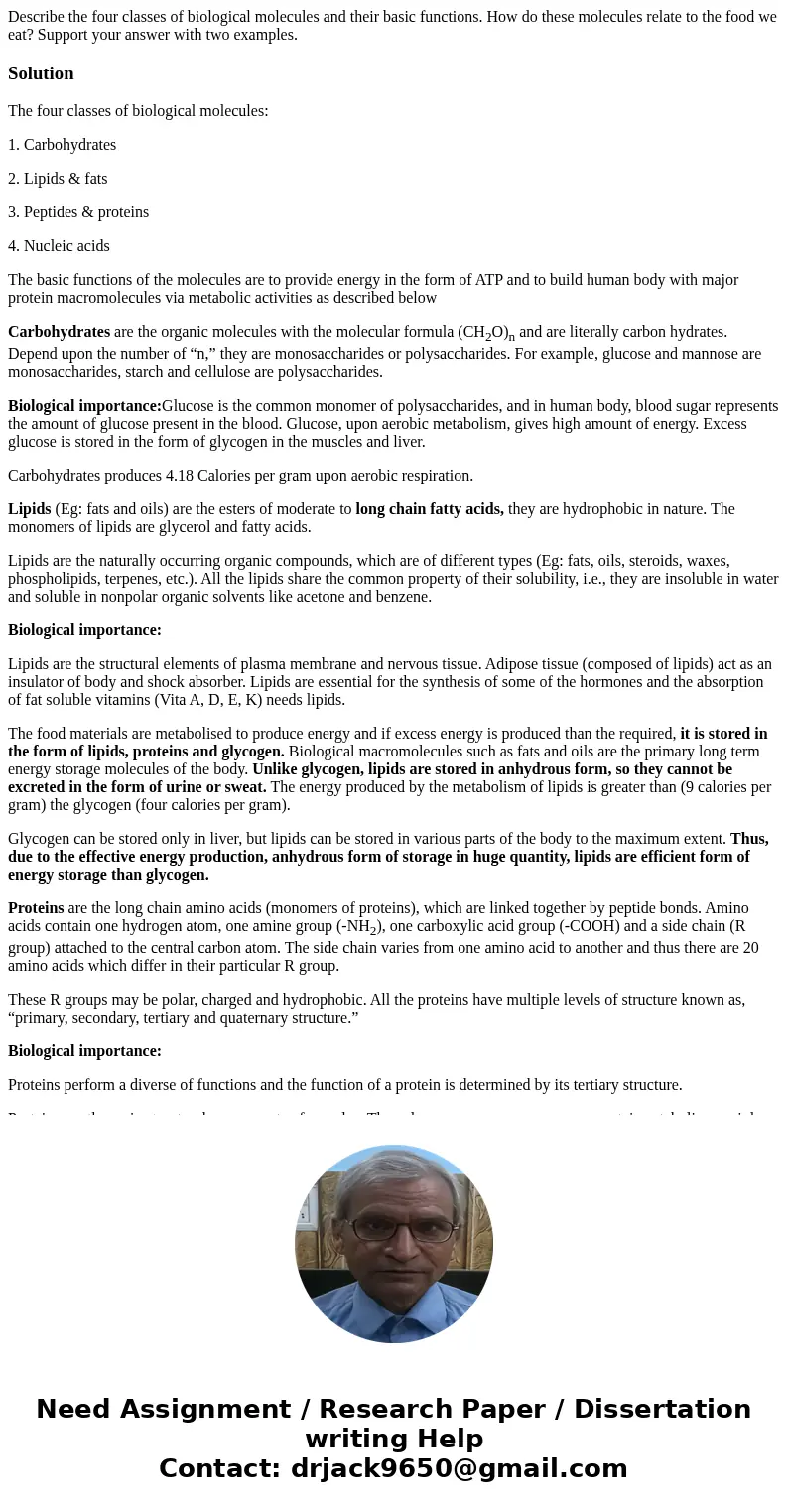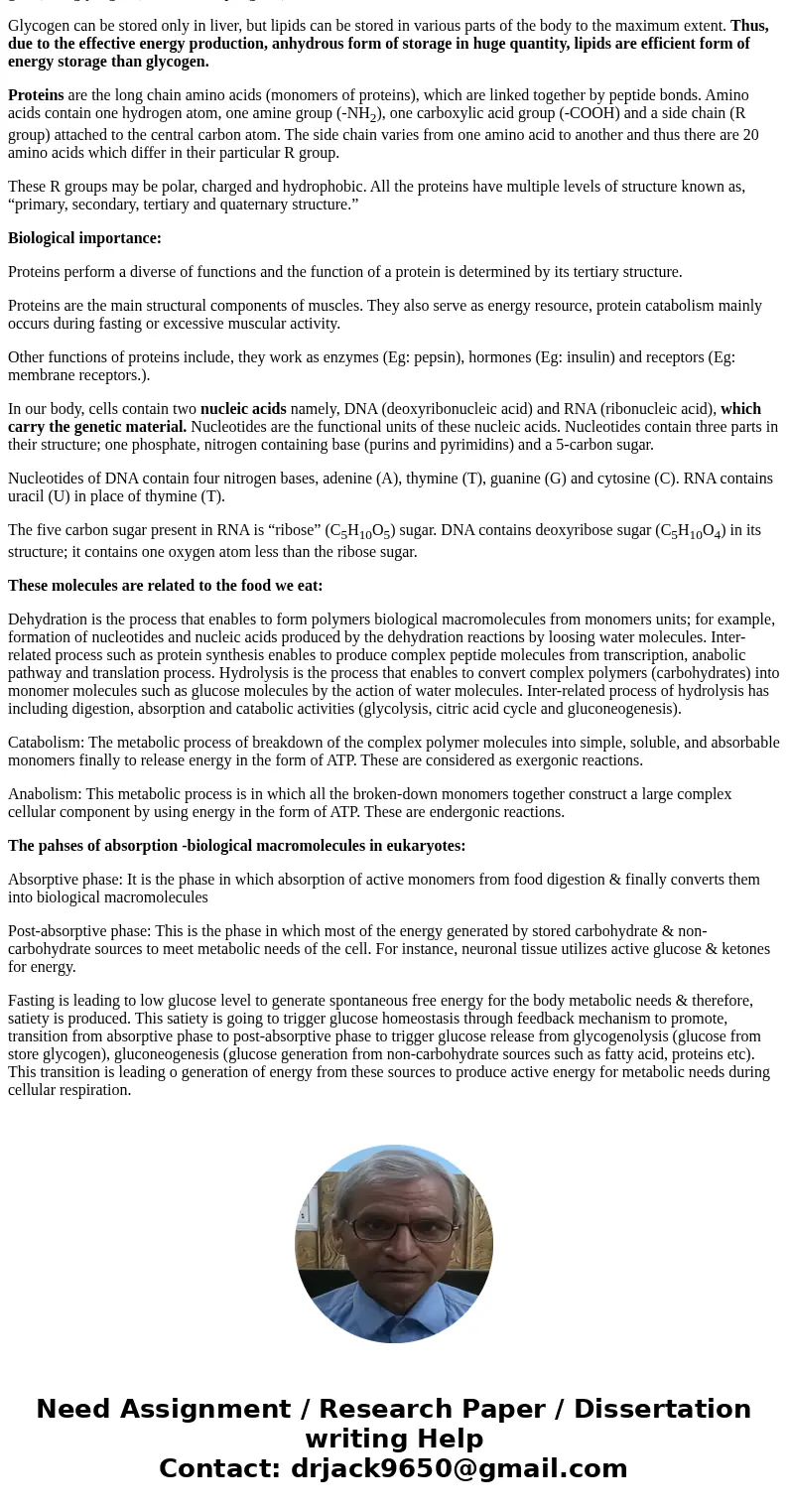Describe the four classes of biological molecules and their
Solution
The four classes of biological molecules:
1. Carbohydrates
2. Lipids & fats
3. Peptides & proteins
4. Nucleic acids
The basic functions of the molecules are to provide energy in the form of ATP and to build human body with major protein macromolecules via metabolic activities as described below
Carbohydrates are the organic molecules with the molecular formula (CH2O)n and are literally carbon hydrates. Depend upon the number of “n,” they are monosaccharides or polysaccharides. For example, glucose and mannose are monosaccharides, starch and cellulose are polysaccharides.
Biological importance:Glucose is the common monomer of polysaccharides, and in human body, blood sugar represents the amount of glucose present in the blood. Glucose, upon aerobic metabolism, gives high amount of energy. Excess glucose is stored in the form of glycogen in the muscles and liver.
Carbohydrates produces 4.18 Calories per gram upon aerobic respiration.
Lipids (Eg: fats and oils) are the esters of moderate to long chain fatty acids, they are hydrophobic in nature. The monomers of lipids are glycerol and fatty acids.
Lipids are the naturally occurring organic compounds, which are of different types (Eg: fats, oils, steroids, waxes, phospholipids, terpenes, etc.). All the lipids share the common property of their solubility, i.e., they are insoluble in water and soluble in nonpolar organic solvents like acetone and benzene.
Biological importance:
Lipids are the structural elements of plasma membrane and nervous tissue. Adipose tissue (composed of lipids) act as an insulator of body and shock absorber. Lipids are essential for the synthesis of some of the hormones and the absorption of fat soluble vitamins (Vita A, D, E, K) needs lipids.
The food materials are metabolised to produce energy and if excess energy is produced than the required, it is stored in the form of lipids, proteins and glycogen. Biological macromolecules such as fats and oils are the primary long term energy storage molecules of the body. Unlike glycogen, lipids are stored in anhydrous form, so they cannot be excreted in the form of urine or sweat. The energy produced by the metabolism of lipids is greater than (9 calories per gram) the glycogen (four calories per gram).
Glycogen can be stored only in liver, but lipids can be stored in various parts of the body to the maximum extent. Thus, due to the effective energy production, anhydrous form of storage in huge quantity, lipids are efficient form of energy storage than glycogen.
Proteins are the long chain amino acids (monomers of proteins), which are linked together by peptide bonds. Amino acids contain one hydrogen atom, one amine group (-NH2), one carboxylic acid group (-COOH) and a side chain (R group) attached to the central carbon atom. The side chain varies from one amino acid to another and thus there are 20 amino acids which differ in their particular R group.
These R groups may be polar, charged and hydrophobic. All the proteins have multiple levels of structure known as, “primary, secondary, tertiary and quaternary structure.”
Biological importance:
Proteins perform a diverse of functions and the function of a protein is determined by its tertiary structure.
Proteins are the main structural components of muscles. They also serve as energy resource, protein catabolism mainly occurs during fasting or excessive muscular activity.
Other functions of proteins include, they work as enzymes (Eg: pepsin), hormones (Eg: insulin) and receptors (Eg: membrane receptors.).
In our body, cells contain two nucleic acids namely, DNA (deoxyribonucleic acid) and RNA (ribonucleic acid), which carry the genetic material. Nucleotides are the functional units of these nucleic acids. Nucleotides contain three parts in their structure; one phosphate, nitrogen containing base (purins and pyrimidins) and a 5-carbon sugar.
Nucleotides of DNA contain four nitrogen bases, adenine (A), thymine (T), guanine (G) and cytosine (C). RNA contains uracil (U) in place of thymine (T).
The five carbon sugar present in RNA is “ribose” (C5H10O5) sugar. DNA contains deoxyribose sugar (C5H10O4) in its structure; it contains one oxygen atom less than the ribose sugar.
These molecules are related to the food we eat:
Dehydration is the process that enables to form polymers biological macromolecules from monomers units; for example, formation of nucleotides and nucleic acids produced by the dehydration reactions by loosing water molecules. Inter-related process such as protein synthesis enables to produce complex peptide molecules from transcription, anabolic pathway and translation process. Hydrolysis is the process that enables to convert complex polymers (carbohydrates) into monomer molecules such as glucose molecules by the action of water molecules. Inter-related process of hydrolysis has including digestion, absorption and catabolic activities (glycolysis, citric acid cycle and gluconeogenesis).
Catabolism: The metabolic process of breakdown of the complex polymer molecules into simple, soluble, and absorbable monomers finally to release energy in the form of ATP. These are considered as exergonic reactions.
Anabolism: This metabolic process is in which all the broken-down monomers together construct a large complex cellular component by using energy in the form of ATP. These are endergonic reactions.
The pahses of absorption -biological macromolecules in eukaryotes:
Absorptive phase: It is the phase in which absorption of active monomers from food digestion & finally converts them into biological macromolecules
Post-absorptive phase: This is the phase in which most of the energy generated by stored carbohydrate & non-carbohydrate sources to meet metabolic needs of the cell. For instance, neuronal tissue utilizes active glucose & ketones for energy.
Fasting is leading to low glucose level to generate spontaneous free energy for the body metabolic needs & therefore, satiety is produced. This satiety is going to trigger glucose homeostasis through feedback mechanism to promote, transition from absorptive phase to post-absorptive phase to trigger glucose release from glycogenolysis (glucose from store glycogen), gluconeogenesis (glucose generation from non-carbohydrate sources such as fatty acid, proteins etc). This transition is leading o generation of energy from these sources to produce active energy for metabolic needs during cellular respiration.


 Homework Sourse
Homework Sourse